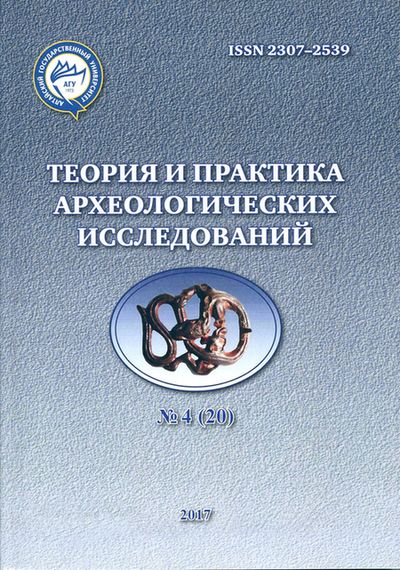APPROBATION OF THE COMPLEX OF GEOPHYSICAL METHODS IN THE OF SEL”UNGUR CAVE (KYRGYZSTAN)
Abstract
The Sel’Ungur cave is the largest karst cavity in Western Central Asia which contains archaeological, paleoanthropological and paleontological remains embedded into several lithological layers. The site was excavated in the 80s of the 20th century when it was defined as the Lower Paleolithic item. As a result of a new study which began in 2014 it was proved that stone complexes from the Sel’Ungur cave have the Middle Paleolithic characteristics. Scientific significance of the site due to the uniqueness of its anthropological and archaeological finds requires further field research. Keeping in mind a formidable size of the cave and a notable thickness of its deposits it is worth applying the latest geophysical methods to choose the most potentially informative areas to excavate. The paper describes the first practice of integrated geophysics methods applied to stratified cave in Central Asia. The application of electromotography and magnetometry methods demonstrated their effectiveness in determining the areas of potential archaeological excavations - minor disturbance by previous excavations, considerable thickness of deposits, and absence of large limestone blocks.
Downloads
Metrics
References
Balkov E.V., Panin G.L., Manshteyn Yu.A., Manshteyn A.K., Beloborodov V.A. Elektrotomografiya: apparatura, metodika i opyt primeneniya [Electromotography: Apparatus, Methods and Experience of Application]. Geofizika [Geophysics]. 2012. №6. Pp. 54–63. [In Russian]. Балков Е. В., Панин Г. Л., Манштейн Ю. А., Манштейн А. К., Белобородов В. А. Электротомография: аппаратура, методика и опыт применения //Геофизика, 2012. №6. С. 54-63.
Islamov U.I., Krakhmal’ K.A. Paleoekologiya i sledy drevnego cheloveka v Tsentral’noy Azii [Paleoecology and Traces of an Ancient Man in Central Asia]. Tashkent, 1995. 220 p [In Russian]. Исламов У. И., Крахмаль К. А. Палеоэкология и следы древнего человека в Центральной Азии. Ташкент, 1995. 220 с.
Krivoshapkin A.I., Viola B., Chargynov T., Kraytsarzh M., Kolobova K.A., Shnayder S.V., Romanenko M.E. Issledovaniya srednepaleoliticheskikh kompleksov peshchery Sel’ungur v polevom sezone 2016 g. [Investigations of the Middle Paleolithic Complexes of the Selungur Cave in the Field Season of 2016]. Problemy arkheologii, etnografii, antropologii Sibiri i sopredel’nykh territoriy [Problems of Archaeology, Ethnography, Anthropology of Siberia and Neighboring Territories]. Novosibirsk: Izd-vo IAET SO RAN, 2016. Vol. XXII. Pp. 94–99. [In Russian]. Кривошапкин А.И., Виола Б., Чаргынов Т., Крайцарж М., Колобова К.А., Шнайдер С.В., Романенко М.Е. Исследования среднепалеолитических комплексов пещеры Сельунгур в полевом сезоне 2016 г. // Проблемы археологии, этнографии, антропологии Сибири и сопредельных территорий. Новосибирск: Изд-во ИАЭТ СО РАН, 2016. Т. XXII. С. 94–99.
Becker H., Fassbinder J. W. E. Magnetic Prospecting in Archaeological Sites. Monuments and Sites. 2001. Munhen: ICOMOS. 104 p.
Conyers L. B., Leckebusch J. Geophysical Archaeology Research Agendas for the Future: Some Ground-penetrating Radar Examples // Archaeological Prospection, 2010. Volume 17, Issue 2. P. 117-123.
Eppelbaum L. V. Archaeological geophysics in Israel: past, present and future / Advances in Geoscience, 2010. Vol. 24. P. 45–68.
David A., Linford N., Linford P. Geophysical Survey in Archaeological Field Evaluation.. London: English Heritage Publishing, 2008. 60 p.
Jrad A., Quesnel Y., Rochette P., Jallouli C., Khatib S., Boukbida H., Demory F. Magnetic investigations of buried palaeohearths inside a Palaeolithic cave (Lazaret, Nice, France) //Archaeological Prospection, 2014. Vol. 21. №. 2. P. 87-101.
Kvamme K. L. Magnetometry: Nature’s gift to archaeology // Remote Sensing in Archaeology: An Explicitly North American Perspective. 2006. Tuscaloosa: University of Alabama Press. P. 205–234.
Loke M.H. RES2DINV ver. 3.50 // Rapid 2-D resistivity and IP inversion using the least square method. 2002. https://moodle.polymtl.ca/pluginfile.php/419838/mod_resource/content/0/MANUELRES2Dinv.pdf
Loke M.H. Res3Dinv Software, Version 2.14 // Geoelectrical imaging 2D&3D, Pinang. 2007. ttp://personales.upv.es/jpadin/coursenotes.pdf
Reeder P. Geoarchaeology and karst: a new perspective // Karst management. Springer Netherlands, 2011. С. 169-200.
Copyright (c) 2017 Теория и практика археологических исследований

This work is licensed under a Creative Commons Attribution-NonCommercial-NoDerivatives 4.0 International License.
Theory and Practice of Archaeological Research is a golden publisher, as we allow self-archiving, but most importantly we are fully transparent about your rights.
Authors may present and discuss their findings ahead of publication: at biological or scientific conferences, on preprint servers, in public databases, and in blogs, wikis, tweets, and other informal communication channels.
Theory and Practice of Archaeological Research allows authors to deposit manuscripts (currently under review or those for intended submission to ABS) in non-commercial, pre-print servers such as ArXiv.
Authors who publish with this journal agree to the following terms:
- Authors retain copyright and grant the journal right of first publication with the work simultaneously licensed under a Creative Commons Attribution License (CC BY 4.0) that allows others to share the work with an acknowledgement of the work's authorship and initial publication in this journal.
- Authors are able to enter into separate, additional contractual arrangements for the non-exclusive distribution of the journal's published version of the work (e.g., post it to an institutional repository or publish it in a book), with an acknowledgement of its initial publication in this journal.
- Authors are permitted and encouraged to post their work online (e.g., in institutional repositories or on their website) prior to and during the submission process, as it can lead to productive exchanges, as well as earlier and greater citation of published work (See The Effect of Open Access).








2.jpg)



